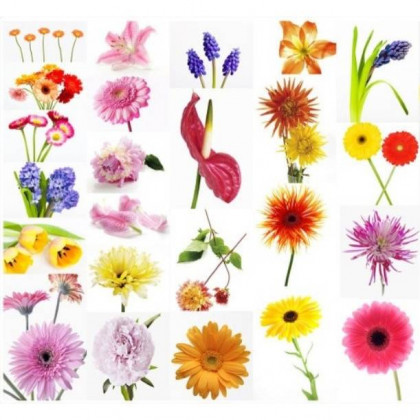Flowers have a non-verbal language with different cultures in each country having particular signs of how they are arranged in the house. Floriography is the way to send flowers to affirm your feelings.
Flowers have a non-verbal language with different cultures in each country having particular signs of how they are arranged in the house. Floriography is the way to send flowers to affirm your feelings.
Flowers often have multiple names to refer to them, but we often use their common names. Have you ever received a pretty bouquet of dianthus? It is the scientific name of the carnation, one of the favorite flowers of all.
Here are some flower choices that you can find out about the various scientific and common names of these popular flowers.
Rose
Scientific name: Rosa
The rose is the most popular flower on the list, it has great cultural force all over the world, and it symbolizes love and affection.
It can be as small as a fingertip to the large Grandiflora, there are thousands of different species of roses in various colors.
Lilies
Scientific name: Lilium
Majestic and impressive, lilies are a popular option for bouquets considering their atypical appearance and fragrance. Lilies are widespread in the northern hemisphere for their elegance and endurance.
If you see Lilium in the name, that means it is a "real lily", several flowers have lily-like attributes and even taking the term in their common name may not be part of the same group.
Tulip
Scientific name: Tulipa
Tulips have been considered a symbol of abundance throughout time.
Being associated with spring and Easter, they are known in Turkey as lale, a term in Arabic letters has the same characters as “Allah”, which makes the flower a sacred figure in the Middle East.
Orchid
Scientific name: Phalaenopsis
This beautiful plant that we usually call an orchid is known as phalaenopsis, which is from Orchidaceae. There are over 28,000 different species of plants in the orchid family, however the phalaenopsis has around sixty and is native to South Asia and Queensland.
The scientific name comes from the Greek phalaena-like, a large moth that looks like it in flight, we will often call them butterfly orchids.
Carnation
Scientific name: Dianthus
The modest dianthus is one of the favorite flowering plants and is native to Europe and Asia. Carnation is a very hardy plant, which is why it is so popular.
We can find them in a wide range of colors. They reflect love, seduction and elegance.
Each color has a different definition:
white: pure love and luck
light red: admiration
dark red: deep love
violet: caprice
rose: the eternal love of a mother.
Freesia
Scientific name: Freesia
Freesias are flowers that originate from the crossing of other flowers grown from a number of flowers in the freesia family. That is why we call them by their scientific name. The name of these magnificent trumpet-shaped flowers does not originate from Latin or Greek, but rather from the name of botanist Friedrich Freese.
Hyacinth
Scientific name: Hyacinthus
Native to the eastern Mediterranean, hyacinths are often mixed with the similar-looking muscari, another blue bulbous plant with its flower clusters along its stem.
We regularly offer hyacinth bulbs in early spring or around Easter, it stems from a Persian tradition of using a flowering hyacinth to garnish the table on the Persian New Year the Nowruz which comes on the spring equinox.
Peruvian Lily
Scientific name: Alstroemeria
Alstroemeria is found almost exclusively in South America, with two distinct species in Chile and Brazil that flowers in winter and summer. The scientific name comes from the Swedish baron Clas Alströmer.
Chrysanthemum
Scientific name: chrysanthemum
The chrysanthemum is mostly found in East Asia and has great value in Chinese, Japanese, and Korean cultures where it can symbolize everything from heartbreak and adversity to depiction of the Japanese imperial family.
Chrysanthemums are part of the "Four Gentlemen" where they represent integrity, loyalty and perseverance to these four flowers.
Gladiolus
Scientific name: Gladiolus
The gladiolus is part of the Iris family, but is often referred to as the "sword lily" for its trumpet resembling true lilies. The scientific name comes from the Latin gladius for sword.
Gladiolus is the flower for a 40th wedding anniversary, a bouquet of red gladioli would go great for a couple celebrating their ruby wedding.
Anemone
Scientific name: anemone
A tough, vibrant and long-lasting flower, the anemone is often referred to as "wind flower" which is a derivative of their scientific name from the Greek god Anemos who ruled the winds.
In literature anemones were created when the goddess Venus strewn nectar on the blood of her late lover Adonis.
Daffodil
Scientific name: Narcissus
Daffodil or narcissus are flowers well known for their botanical and medicinal power.
The story of the vain young Narcissus who was obsessed with his reflection in water that he drowned is the most common one. The sight of daffodils on a lake may look like, but it has also been said that the daffodil reproduces the scent of many different flowers.
Poppy
Scientific name: Papaver
Beautiful flower, but deadly. Long known to contain potent drugs such as narcotics, morphine, opium and codeine are all made from papaver somniferum - these peaceful flowers symbolize sleep.
Poppies are often seen in temperate and subtropical environments.
Sunflower
Scientific name: Helianthus
Sunflower takes its name from the Greek for sun "helios" and flower "anthus", a beautiful characteristic American plant known for its bright flower with a brown center.
This giant and imposing sunflower can rise up to 300 cm in height.
 | SAME DAY DELIVERY AVAILABLE FOR ORDERS PLACED BEFORE 14H
| SAME DAY DELIVERY AVAILABLE FOR ORDERS PLACED BEFORE 14H

Leave Your Comment